Addition of Phosphogypsum to Fire-Resistant Plaster Panels: A Physic–Mechanical Investigation
Abstract
:1. Introduction
2. Results and Discussions
2.1. Morphological and Physico-Chemical Properties
| no mass loss of PG (0%), with pH = 2.2; |
| low mass loss of PG (2.79%), with pH = 2.4; |
| significant mass loss of PG (31.51%), with pH = 5. |
2.2. Composites Physical-Mechanical Properties
3. Materials and Methods
3.1. Materials
3.1.1. Phosphogypsum Pre-Treatments
3.1.2. Composite Preparation
- -
- Case A: Mixture of plaster with raw PG (WS0, pH = 2.2);
- -
- Case B: Mixture of plaster with washed PG (WS1, pH = 2.4);
- -
- Case C: Mixture of plaster with washed PG (WS5, pH = 5).
- First, mix the plaster and PG dry powder with a vacation step equal to 10% (Table 4);
- Next, add mixed water to keep the water/plaster ratio constant (0.75) while mixing the mixture well for about 5 min;
- Then, add the mixture into a standard-sized mold of 4 × 4 × 16 cm3;
- Finally, after checking its hardened state, the specimen is removed from the mold on the day of casting.
3.2. Characterization Methods
3.2.1. Mineralogy and Morphological Characteristics
3.2.2. Mechanical Properties Testing
- -
- Heat flux (heat passing through a surface over time);
- -
- Burn duration (15, 30, 45, and 60 min);
- -
- The distance between the flame and the sample (about 30 cm);
- -
- Sample thickness (40 mm).
- -
- The mass fraction lost (preservation of structure after each fire duration);
- -
- The compressive strength of the samples which did not break after 60 min of burning.
4. Conclusions
Author Contributions
Funding
Data Availability Statement
Acknowledgments
Conflicts of Interest
References
- Gypsum Statistics Investigation in 2019. Available online: https://fr.statista.com/statistiques/565286/principaux-pays-producteurs-miniers-de-gypse/ (accessed on 24 April 2020).
- Phosphate Production in Tunisia in 2019. Available online: http://www.cpg.com.tn/#/production (accessed on 10 October 2022).
- Ben Ismail, M.H. Jurassic evaporitic deposits in southern Tunisia: A climatically and tectonically controlled sedimentation. J. Afric. Earth. Sci. 1991, 12, 117–123. [Google Scholar] [CrossRef]
- Bumanis, G.; Zorica, J.; Bajare, D. Properties of Foamed Lightweight High-Performance Phosphogypsum-Based Ternary System Binder. Appl. Sci. 2020, 10, 6222. [Google Scholar] [CrossRef]
- Kang, L.; Wei, C.; Jihong, Y.; Jianyue, M.; Jian, J. Influence of different gypsum plasterboards on the fire performance of cold-formed steel walls. Structures 2022, 46, 159–171. [Google Scholar] [CrossRef]
- Bouzit, S.; Merli, F.; Belloni, E.; Akhrraz, R.; Asri Ssar, S.; Sonebi, M.; Amziane, S.; Buratti, C.; Tahaa, M. Investigation of thermo-acoustic and mechanical performance of gypsum-plaster and polyester fibers based materials for building envelope. Mater. Proc. 2022, 58, 1578–1581. [Google Scholar] [CrossRef]
- Benjeddou, O.; Soussi, C.; Benali, M.; Alyousef, R. Experimental investigation of a new ecological block made by mixing gypsum plaster and desert sand. Arab. J. Sci. Eng. 2020, 45, 4037–4052. [Google Scholar] [CrossRef]
- Jedidi, M.; Abroug, A. Valorization of Posidonia oceanica Balls for the Manufacture of an Insulating and Ecological Material. Jordan J. Civ. Eng. 2020, 14, 417. Available online: https://jjce.just.edu.jo/issues/paper.php?p=5019.pdf (accessed on 4 June 2020).
- Hamdi, A.; Ben Jamaa, N.; Kammoun, I.K. Potential use of phosphogypsum in paving blocks. Green Mater. 2021, 9, 97–107. [Google Scholar] [CrossRef]
- Zheng, T.; Lu, Y.; Luo, S.; Kong, D.; Fu, R. Effect of the phosphogypsum calcination time on the compressive mechanical properties of phosphogypsum-based composite cementitious materials. Mater. Res. Express 2022, 9, 035506. [Google Scholar] [CrossRef]
- Arunvivek, G.K.; Rameshkumar, D. Experimental investigation on feasibility of utilizing phosphogypsum in E-Glass Fiber-incorporated Non-fired Ceramic wall tile. J. Inst. Eng. Ser. A 2022, 103, 445–451. [Google Scholar] [CrossRef]
- Macías, F.; Pérez-López, R.; Cánovas, C.R.; Carrero, S.; Cruz-Hernandez, P. Environmental assessment and management of phosphogypsum according to European and United States of America regulations. Procedia Earth Planet. Sci. 2017, 17, 666–669. [Google Scholar] [CrossRef] [Green Version]
- Commercial Production of Tunisian Phosphate in 2022. Available online: https://www.webmanagercenter.com/2022/07/06/489319/phosphate-plus-de-2-milliphosphate-record-de-production-au-1er-semestre-2022ons-tonnes-produites-au-1er-semestre-2022/ (accessed on 6 July 2022).
- Chernysh, Y.; Yakhnenko, E.; Chubur, V.; Roubik, H. Phosphogypsum Recycling: A Review of Environmental Issues, Current Trends, and Prospects. Appl. Sci. 2021, 11, 1575. [Google Scholar] [CrossRef]
- Zairi, M.; Rouis, M.J. Impacts environnementaux du stockage du phosphogypse à Sfax (Tunisie). Bull. Des Lab. Des Ponts Et Chaussées 1999, 219, 29–40. [Google Scholar]
- El Zrelli, R.; Rabaoui, L.; Abda, H.; Daghbouj, N.; Pérez-Lopez, R.; Castet, S.; Aigouy, T.; Bejaoui, N.; Courjault-Radé, P. Characterization of the role of phosphogypsum foam in the transport of metals and radionuclides in the Southern Mediterranean Sea. J. Hazard. Mater. 2019, 363, 258–267. [Google Scholar] [CrossRef] [PubMed]
- Pliaka, M.; Gaidajis, G. Potential uses of phosphogypsum: A review. J. Environ. Sci. Health Part A 2022, 57, 746–763. [Google Scholar] [CrossRef]
- Costa, S.; Tarso, E.; Lopes, G.; Carvalho, G.S.; Penha, H.G.V.; Curi, N.; Guilherme, L.R.G. Phytoremediation of Arsenic-contaminated soils amended with red mud combined with phosphogypsum. Water Air Soil Pollut. 2021, 232, 417. [Google Scholar] [CrossRef]
- Huang, L.; Liu, Y.; Ferreira, J.F.S.; Wang, M.; Na, J.; Huang, J.; Liang, Z. Long-term combined effects of tillage and rice cultivation with phosphogypsum or farmyard manure on the concentration of salts, minerals, and heavy metals of saline-sodic paddy fields in Northeast China. Soil Tillage Res. 2014, 215, 105222. [Google Scholar] [CrossRef]
- Moalla, R.; Gargouri, M.; Khmiri, F.; Kamoun, L.; Zairi, M. Phosphogypsum purification for plaster production: A process optimization using full factorial design. Environ. Eng. Res. 2017, 23, 36–45. [Google Scholar] [CrossRef] [Green Version]
- Koopman, C.; Witkamp, G.J.; Van Rosmalen, G.M. Removal of Heavy Metals and Lanthanides from Industrial Phosphoric Acid Process Liquors. Sep. Sci. Technol. 1999, 34, 2997–3008. [Google Scholar] [CrossRef]
- Nils, H.; Sofia, B.M.; Dolores, B.; Martin, B.; Essaid, B.; Ewelina, C.; Yelizaveta, C.; Viktoriia, C.; João, C.; Krzysztof, D.; et al. Closing the upcoming EU gypsum gap with phosphogypsum. Resour. Conserv. Recycl. 2022, 182, 106328. [Google Scholar] [CrossRef]
- SfarFelfoul, H.; Clastres, P.; Ben Ouezdou, M. Gestion des sous-produitsindustriel et développement durable, cas du phosphogypse de sfax (TUNISIE). Sci. Technol. B-N°23 2005, 23, 66–81. Available online: https://www.asjp.cerist.dz/en/downArticle/407/0/23/58314 (accessed on 23 June 2005).
- Zhou, J.; Li, X.; Zhao, Y.; Shu, Z.; Wang, Y.; Zhang, Y.; Shen, X. Preparation of paper-free and fiber-free plasterboard with high strength using phosphogypsum. Constr. Build. Mater. 2020, 243, 118091. [Google Scholar] [CrossRef]
- Jong, K.Y.J.; Yew, M.C.; Yew, M.K.; Ting, C.H.; Saw, L.H.; Ng, T.C.; Yeo, W.H.; Beh, J.H. Fire Resistance and Mechanical Properties of the Fire-Resistant Board. Adv. Mater. Sci. Eng. 2021, 2020, 249–256. [Google Scholar] [CrossRef]
- Moncer, A.; Ben Jamaa, N.; Bagane, M.; Chekir, H.; Chtara, H. Etude de la fabrication de ciment à partir du phosphogypse. Int. J. Sci. Res. Eng. Technol. 2016, 102–106. Available online: http://ipco-co.com/IJSET/GEEE-206/17.pdf (accessed on 10 October 2022).
- Whyte, J.; Bush, K. Update on Canada’s National Radon Program. In Proceedings of the Health Canada CARST 2014 Conference, Mississauga, Ont, Canada, 4–6 May 2014. [Google Scholar]
- Ajam, L.; Ben El Haj Hassen, A.; Reguigui, N. Phosphogypsum utilization in fired bricks: Radioactivity assessment and durability. J. Build. Eng. 2019, 26, 100928. [Google Scholar] [CrossRef]
- Reguigui, N.; SfarFelfoul, H.; Ben Ouezdou, M.; Clastres, P. Radionuclide levels and temporal variation in phosphogypsum. J. Radioanal. Nucl. Chem. 2005, 264, 719–722. [Google Scholar] [CrossRef]
- Arhouni, F.E.; Hakkar, M.; Mahrou, A.; Belahbib, L.; Mazouz, H.; Haneklaus, N.; Pavon, S.; Bertau, M.; Boukhair, A.; Ouakkas, S.; et al. Better filterability and reduced radioactivity of phosphogypsum during phosphoric acid production in Morocco using a fly ash waste and pure silica additive. J. Radioanal. Nucl. Chem. 2022, 331, 1609–1617. [Google Scholar] [CrossRef]
- Borrego, E.; Mas, J.L.; Martin, J.E.; Bolivar, J.P.; Vaca, F.; Aguado, J.L. Radioactivity levels in aerosol particles surrounding a large TENORM waste repository after application of preliminary restoration work. Sci. Total Environ. 2007, 377, 27–35. [Google Scholar] [CrossRef]
- Mazzilli, B.; Palmiro, V.; Saueia, C.; Nistin, M.B. Radiochemical characterization of Brazilian phosphogypsum. J. Environ. Radioact. 2000, 49, 113–122. [Google Scholar] [CrossRef]
- Berekta, J. The current state of utilization of phosphogypsum in Australia. In Proceedings of the Third International Symposium on Phosphogypsum, Bartow, FL, USA, December 1990; Volume 2, pp. 394–401. [Google Scholar]
- Bigu, J.; Hussein, M.I.; Hussein, A.Z. Radioactivity measurements in Egyptian phosphate mines and their significance in the occupational exposure of mine workers. J. Environ. Radioact. 2000, 47, 229–243. [Google Scholar] [CrossRef]
- Predrag, K.; Nataša, T.; Sofija, F.; Leposava, F.P.; Jovana, K.; Jovana, N.; Bojan, M. Radiological characterization of phosphogypsum produced in Serbia. Radiat. Phys. Chem. 2020, 166, 108463. [Google Scholar] [CrossRef]
- Rutherford, P.M.; Dudas, M.J.; Arocena, J.M. Heterogeneous distribution of radionuclides, barium and strontium in phosphogypsum by-product. Sci. Total Environ. 1996, 180, 201–209. [Google Scholar] [CrossRef]
- Ghali, B.M.; Bouargane, B.; Ldboufrade, A.; Marrouche, A.; Ali, A.; Boukbir, L.; Billah, S.M. New procedure for water-salinity reduction using phosphogypsum waste and carbon dioxide resulting in useful compounds formation. Nanotechnol. Environ. Eng. 2021, 6, 33. [Google Scholar] [CrossRef]
- Liatsou, I.; Christodoulou, E.; Pashalidis, I. Thorium adsorption by oxidized biochar fibres derived from Luffa cylindrica sponges. J. Radioanal. Nucl. Chem. 2018, 317, 1065–1070. [Google Scholar] [CrossRef]
- Eur Stand EN 13279-1; Gypsum Binders and Gypsum Plasters Part 1: Definitions and Requirements. European Committee For Standardization: Brussels, Belgium, 2008; pp. 3–20.
- EU (European Union) 2013Council Directive 2013/59/Euratom of 5 December 2013 Laying Down Basic Safety Standards for Protection against the Dangers Arising from Exposure to Ionising Radiation, and Repealing Directives 89/618/Euratom, 90/641/Euratom, 96/29/Euratom, 97/43/Euratom and 2003/122/Euratom. Official Journal of the European Union L13/1. 17 January 2014, pp. 1–73. Available online: https://eur-lex.europa.eu/eli/dir/2013/59/oj (accessed on 10 October 2022).
- NormeFrancaise, NormeEuropéenne 196-1; Méthodesd’essais des ciments. Partie 1: Détermination des RésistancesMécaniques. Committee For Standardization: Brussels, Belgium, 1995.
- ISO 11925-2; Reaction to Fire Tests. Ignitability of Products Subjected to Direct Impingement of Flame. Part 2: Single-Flame Source Test. The International Organization for Standardization (ISO): Geneva, Switzerland, 2010.
- NormeFrancaise, NormeEuropéenne 1097-6; Essais Pour Déterminer les Caractéristiques Mécaniques et Physiques des Granulats. Partie 6: Détermination de la Masse VolumiqueRéelle et du Coefficient D’absorptionD’eau. Committee For Standardization: Brussels, Belgium, 2014.

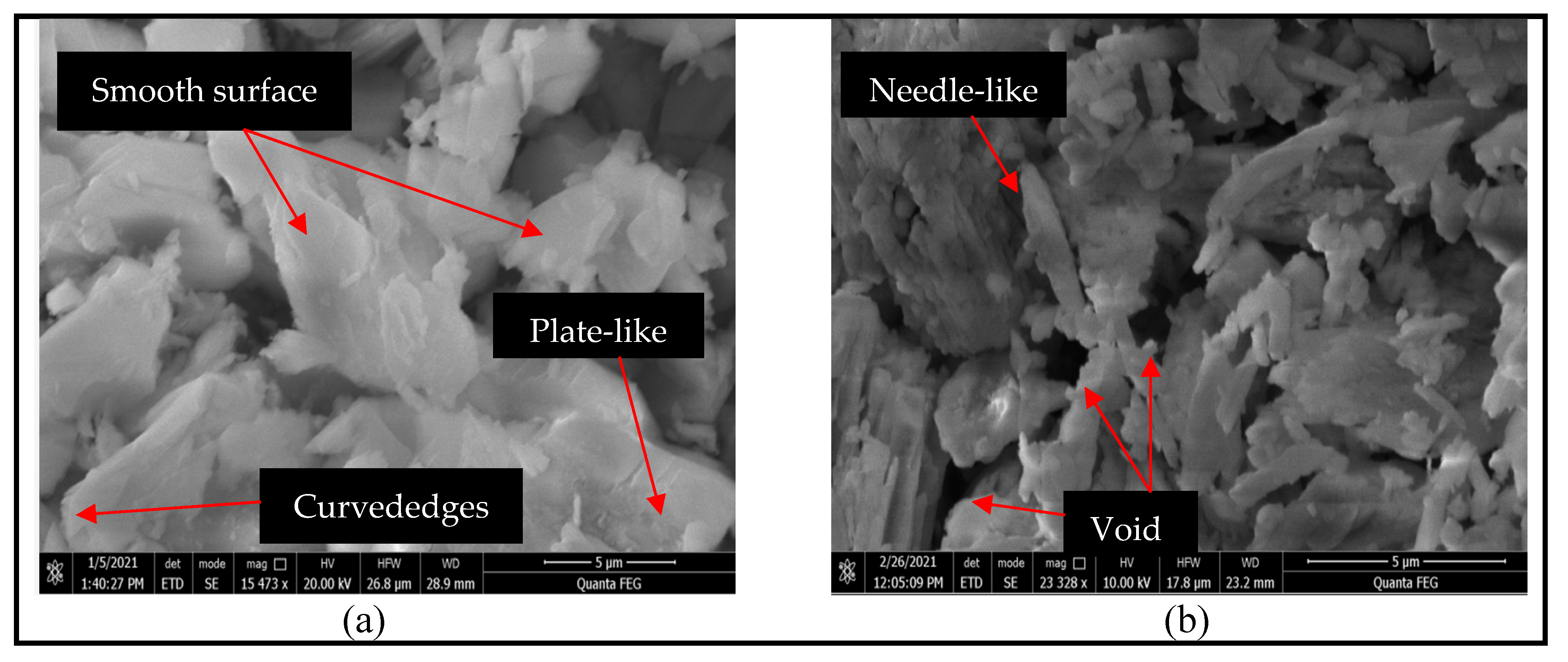
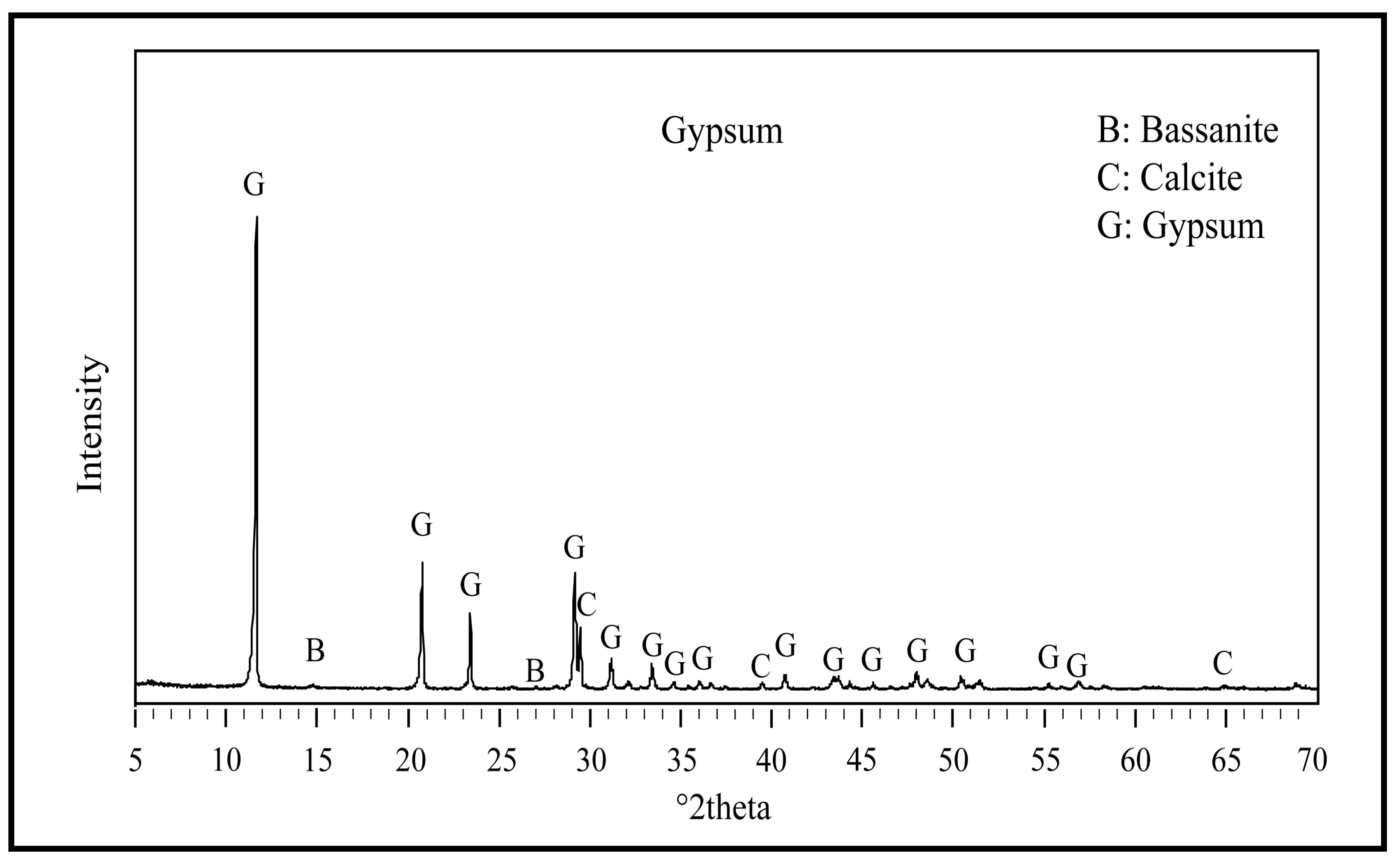
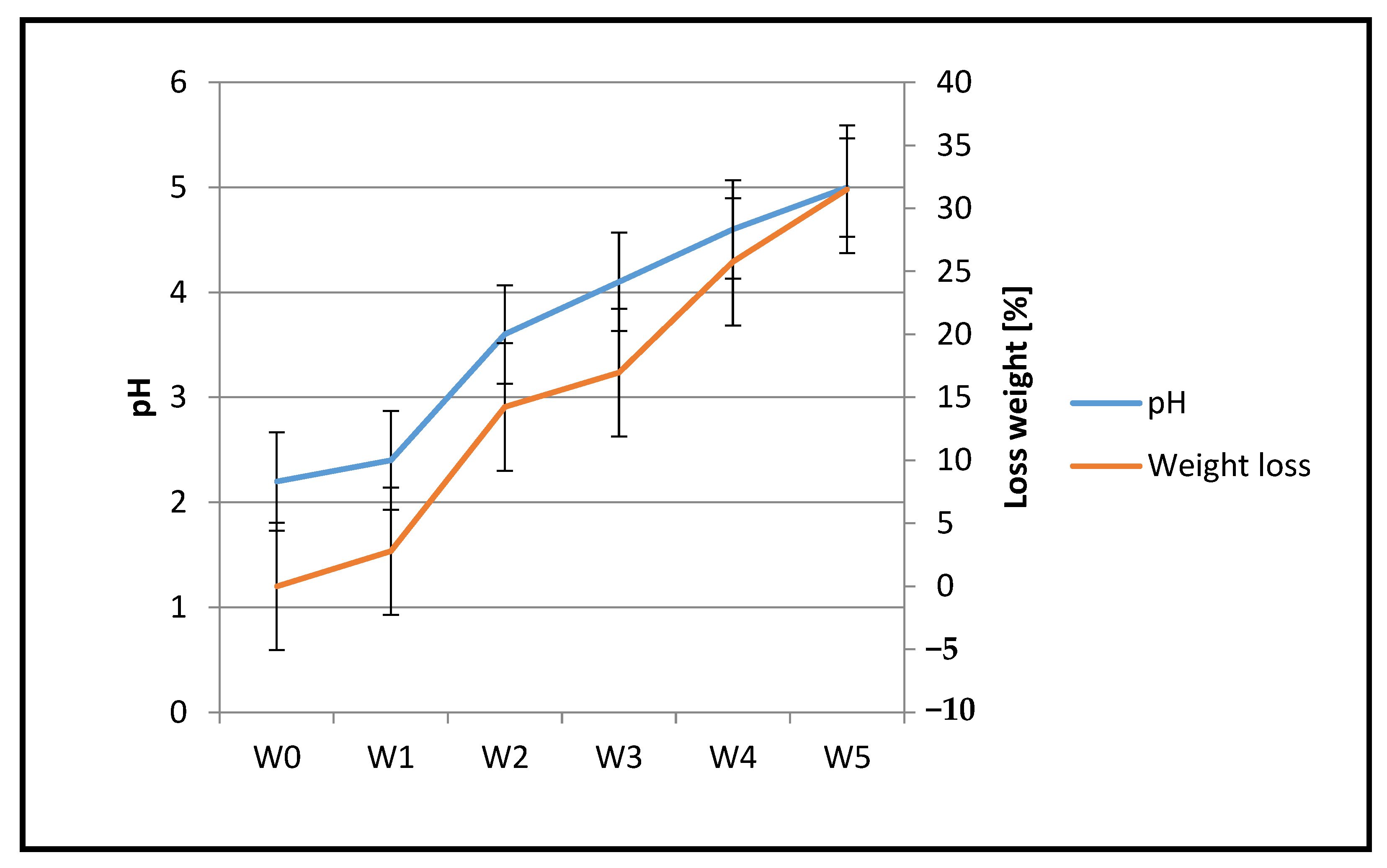
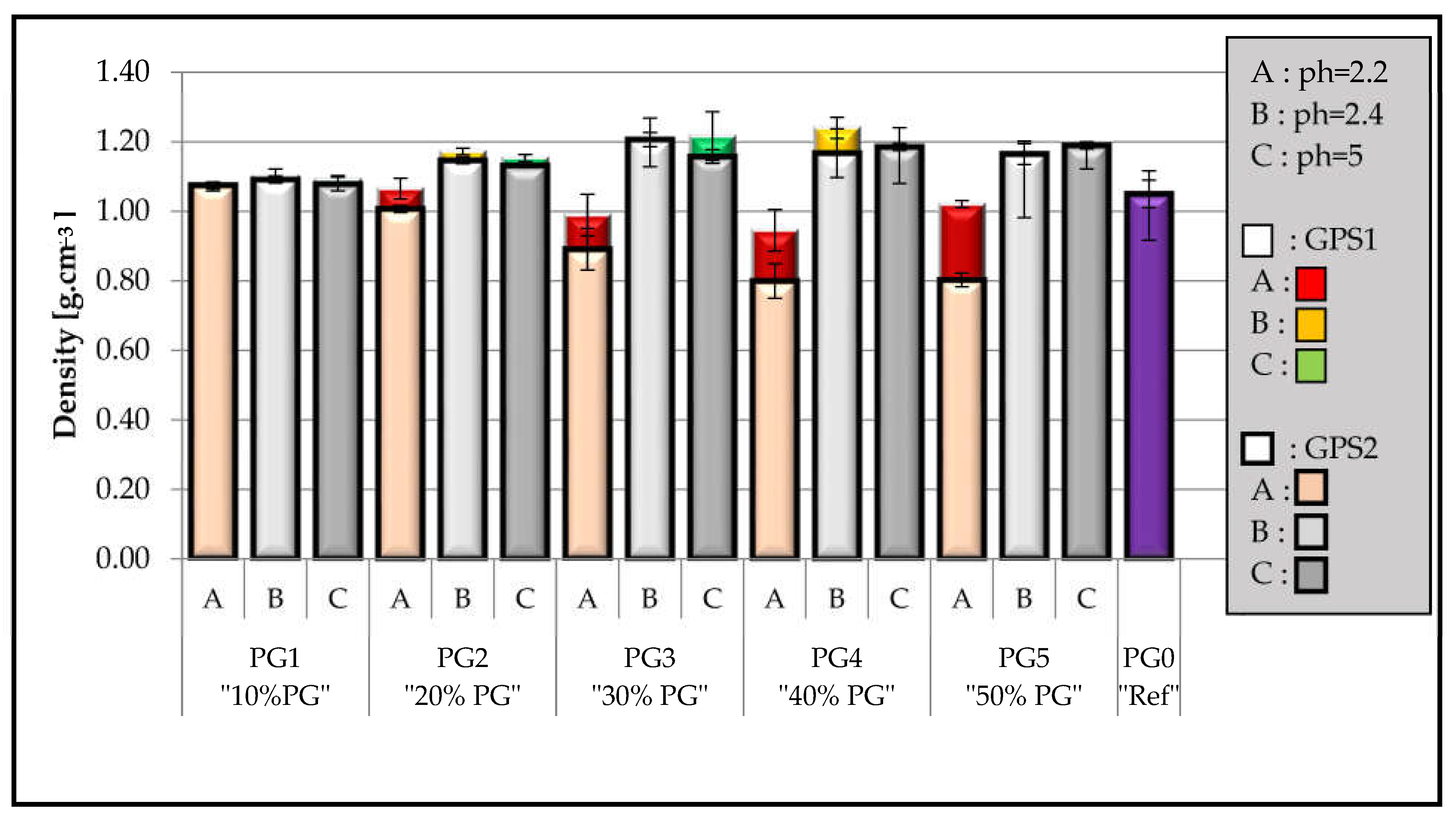

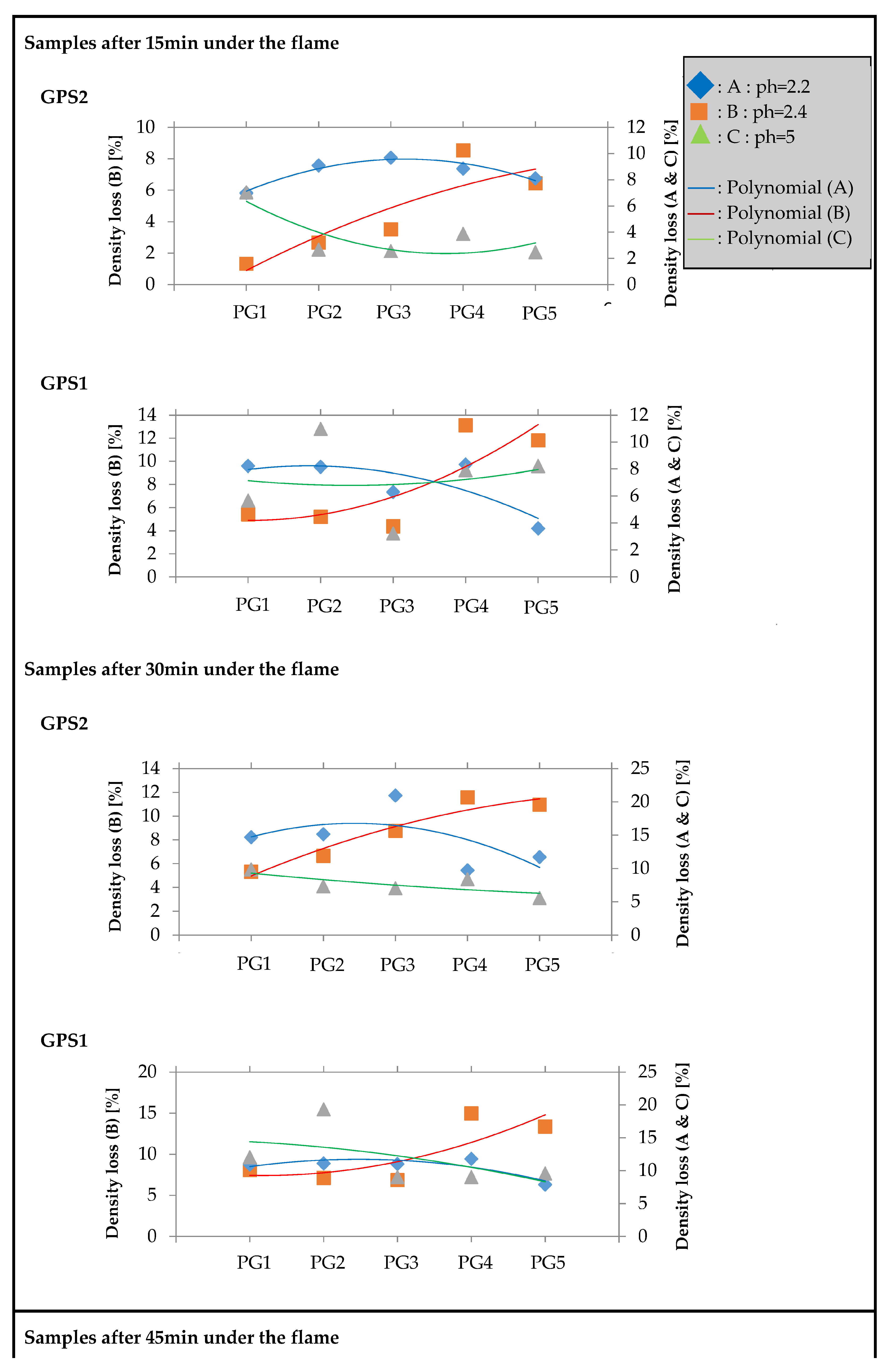


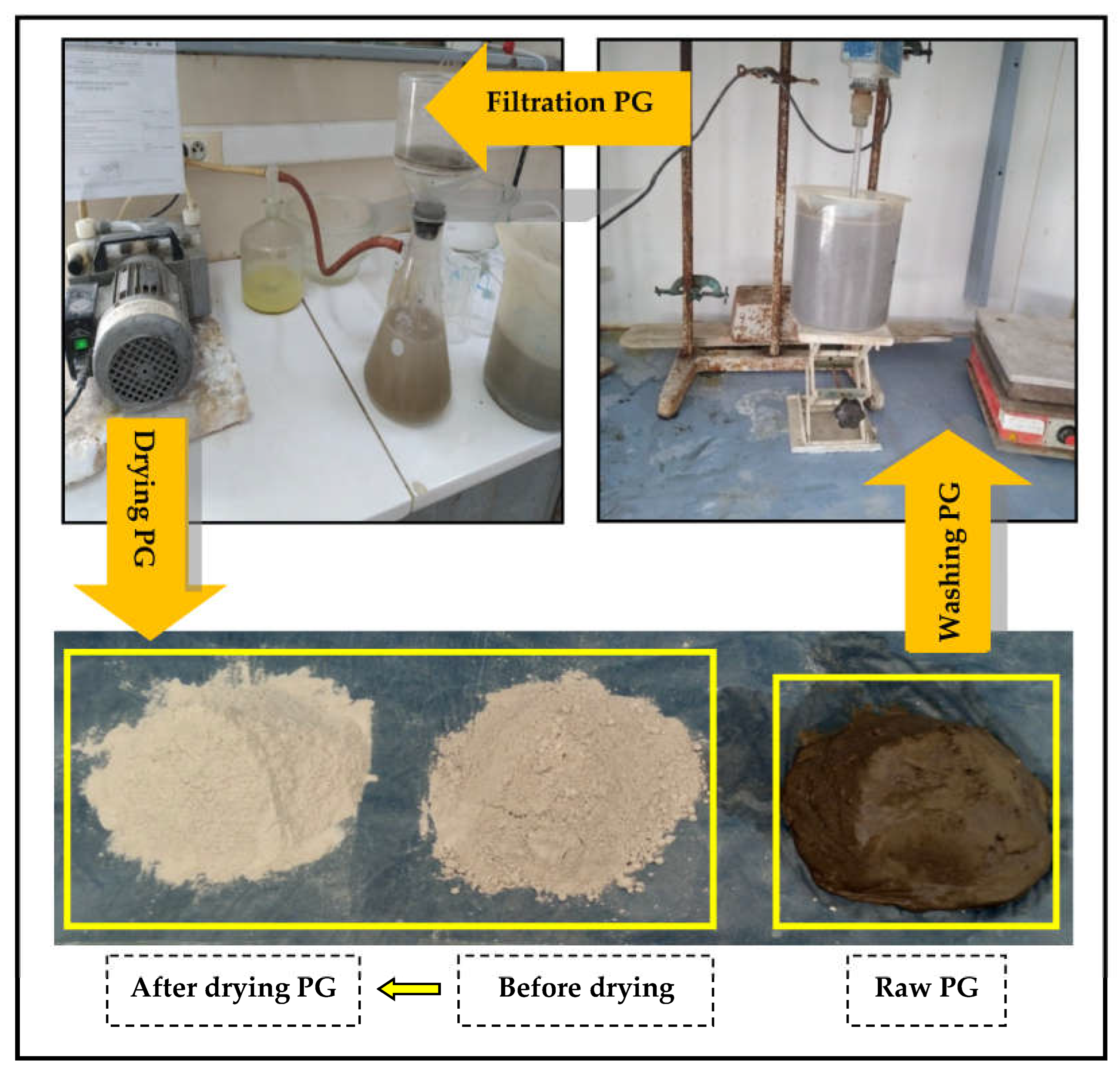
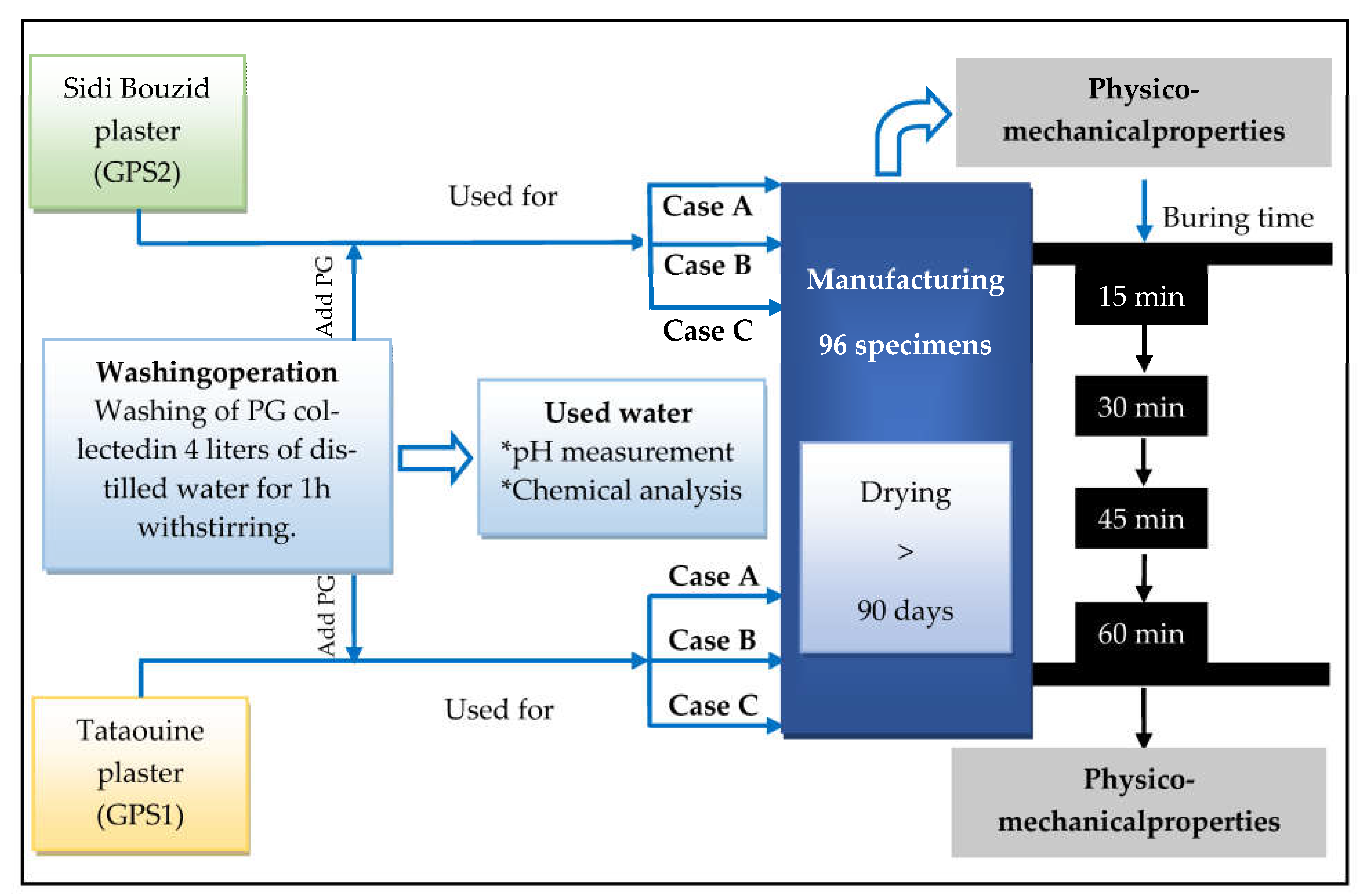

| Ca % | % | % | F− % | Mg % | Cd % | Fe % | |
|---|---|---|---|---|---|---|---|
| WS1 * | 96.55 | 22.86 | 74.00 | 1.59 | 32.81 | 91.30 | 7.97 |
| WS2 * | 31.03 | 20.00 | 58.54 | 0.43 | 1.19 | 86.96 | 5.28 |
| WS3 * | 33.45 | 10.29 | 51.22 | 0.38 | 0.37 | 108.70 | 3.68 |
| WS4 * | 33.10 | 9.43 | 52.44 | 0.38 | 0.20 | 69.57 | 3.26 |
| WS5 * | 33.10 | 4.29 | 36.58 | 0.29 | 0.00 | 56.52 | 3.00 |
| Properties | Values | Test Method | |
|---|---|---|---|
| Purity | >94% | ASTM test purity | |
| Density | 1.05 (g.cm−3) | Tests for mechanical and physical properties of aggregates | |
| Slump test | 180 ± 10 (mm) | Slump test | |
| Beginning of setting | 7–8 (min) | ||
| End of setting (Shore 40) | 20–22 (min) | Setting time test | |
| End of setting (Shore 60) | 22–26 (min) | ||
| Mass heat capacity | 1000 (J.kg−1.K−1) | Thermal siffusivity measurement | |
| Flexural strength (N/mm2) | 2 h | 7 days | Three-point bending test |
| >1.5 | >3 | ||
| Surface hardness (N/mm2) | 2 h | 7 days | Compression strength test |
| >4 | >10 | ||
| Sieve size | Residue at 200 μm | Residue at 100 μm | ASTM test sieves |
| ≤1% | ≤10% | ||
| Origin of PG | U238 | Ra226 | Th232 | References |
|---|---|---|---|---|
| Tunisia (Gabès region) | 45.4 | 18.9 | [9] | |
| Tunisia | 35 ± 2 to 66 ± 4 | 209 ± 8 to 223 ± 8 | 8 ± 1 to 20 ± 2 | [29] |
| Morocco | 1191 | 1032 | Below detection limit | [30] |
| Morocco (use in Spain) | 140 | 620 | [31] | |
| Brazil | 17 ± 5 to 42 ± 6 | 100 ± 7 to 695 ± 47 | 156 ± 38 to 175 ± 23 | [32] |
| Flodida, USA | 130 | 1120 | 3.7 | [33] |
| Egypt | 134 | 411 | 19 | [34] |
| Serbia | - | 488 ± 15 to 737 ± 8 | 2.1 ± 0.8 to 4.5 ± 0.9 | [35] |
| Limit values | 1.104 | 1.103 | [36] |
| Samples | Cases | XmP * | XmPG * | W/P * |
|---|---|---|---|---|
| Raw/Washed | [wt%] | [wt%] | ||
| PG0 * | 100 | 0 | ||
| A | ||||
| PG1 | B | 90 | 10 | |
| C | ||||
| A | ||||
| PG2 | B | 80 | 20 | |
| C | 0.75 | |||
| A | ||||
| PG3 | B | 70 | 30 | |
| C | ||||
| A | ||||
| PG4 | B | 60 | 40 | |
| C | ||||
| A | ||||
| PG5 | B | 50 | 50 | |
| C |
Disclaimer/Publisher’s Note: The statements, opinions and data contained in all publications are solely those of the individual author(s) and contributor(s) and not of MDPI and/or the editor(s). MDPI and/or the editor(s) disclaim responsibility for any injury to people or property resulting from any ideas, methods, instructions or products referred to in the content. |
© 2023 by the authors. Licensee MDPI, Basel, Switzerland. This article is an open access article distributed under the terms and conditions of the Creative Commons Attribution (CC BY) license (https://creativecommons.org/licenses/by/4.0/).
Share and Cite
Guedri, A.; Abdallah, F.; Mefteh, N.; Hamdi, N.; Baeza-Urrea, O.; Wagner, J.-F.; Zagrarni, M.F. Addition of Phosphogypsum to Fire-Resistant Plaster Panels: A Physic–Mechanical Investigation. Inorganics 2023, 11, 35. https://doi.org/10.3390/inorganics11010035
Guedri A, Abdallah F, Mefteh N, Hamdi N, Baeza-Urrea O, Wagner J-F, Zagrarni MF. Addition of Phosphogypsum to Fire-Resistant Plaster Panels: A Physic–Mechanical Investigation. Inorganics. 2023; 11(1):35. https://doi.org/10.3390/inorganics11010035
Chicago/Turabian StyleGuedri, Abdessalam, Fatma Abdallah, Nourhen Mefteh, Noureddine Hamdi, Oscar Baeza-Urrea, Jean-Frank Wagner, and Mohamed Faouzi Zagrarni. 2023. "Addition of Phosphogypsum to Fire-Resistant Plaster Panels: A Physic–Mechanical Investigation" Inorganics 11, no. 1: 35. https://doi.org/10.3390/inorganics11010035







